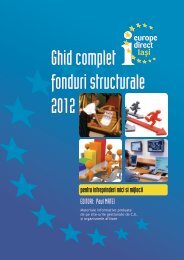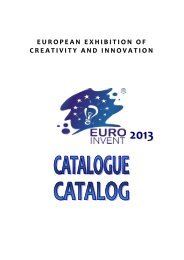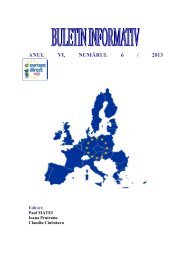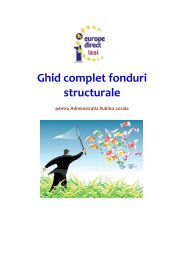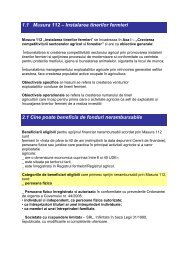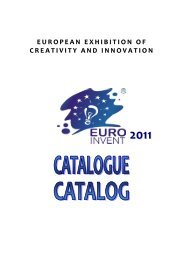2012 - Europe Direct Iasi
2012 - Europe Direct Iasi
2012 - Europe Direct Iasi
Create successful ePaper yourself
Turn your PDF publications into a flip-book with our unique Google optimized e-Paper software.
EUROINVENT <strong>2012</strong><br />
the gaseous to the liquid phase, is a vital part of a number of<br />
wastewater treatment processes. Because of the low solubility of<br />
oxygen and the consequent low rate of oxygen transfer, the needed<br />
quantity of oxygen required for aerobic waste treatment through<br />
normal surface air-water interface is insufficient.<br />
To transfer the needed large quantities of oxygen, additional<br />
interfaces must be formed. Submerged bubbles aeration is most<br />
frequently accomplished by dispersing air bubbles into the liquid.<br />
The diffused or bubble aeration process consists of contacting gas<br />
bubbles with water for the purpose of transferring gas to the water.<br />
The most commonly used diffuser system consists of a matrix of<br />
perforated tubes/membranes or porous plates arranged near the<br />
bottom of the tank. Such a system was considered in the present<br />
research.<br />
Both results (from numerical simulations and experimental<br />
researches) show that the introduction of biomedia in the reactor<br />
increases the time contact between air bubbles and water and so<br />
the mass transfer of oxygen is more efficient.<br />
X. 17.<br />
Title “Mini”Class Underwater Remotely Operated Vehicle<br />
Authors Octavian Tărăbuță, Vasile Dobref<br />
Institution “Mircea cel Batran” Naval Academy<br />
Description<br />
The Remotely Operated Vehicles (or ROV) are dedicated<br />
underwater systems with various degrees of autonomy,<br />
controlled by a human operator. ROVs may be fitted with a large<br />
array of sensors for visual or acoustic inspection of submerged<br />
targets or for measurement of hydrographic parameters as<br />
temperature, salinity, density, etc.<br />
The ROV presented has relatively small dimensions (900 x 300 x<br />
400 mm) that put it in the so-called “mini” class. The research<br />
team chose to propel the ROV with 2 horizontal and 2 vertical<br />
DC motors that provide the necessary movement in the water.<br />
For a better hydrodynamic behavior, the components are<br />
enclosed in a watertight streamlined body designed to withstand<br />
pressures of up to 4 bars. The control commands and the<br />
information from sensors (optical, depth, course, motors speed)<br />
are given and received through a laptop where the interface<br />
software is loaded.<br />
The novelty of this project is given by the low cost of the ROV.<br />
Innovative Researches<br />
175



